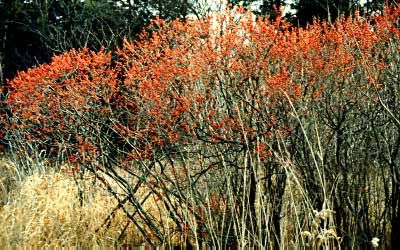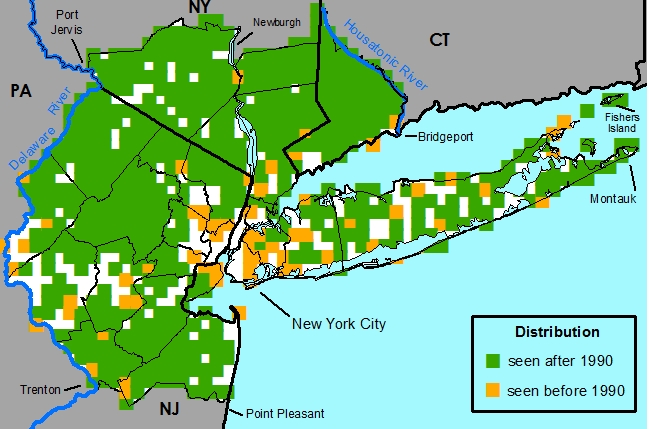Ilex verticillata (L.) Gray - Winterberry,Black Alder,Bitter
Common Names
Winterberry,Black Alder,BitterField Identification
Deciduous large upright shrub with alternate, simple, minutely-toothed leaves and with globose red fruit on female specimens; most easily confused with Ilex laevigata. Stems usually beset with small white lenticels.Medicinal uses
Disclaimer: The information provided here is for reference and historical use. We do not recommend nor do we condone the use of this species for medicinal purposes without first consulting a physician.
Native Americans used various parts for the treatment of upset stomach, fever, lethargy, hay fever, and diarrhea.
Other uses
This species is used as an ornamental in landscaping with over 30 cultivars selected.
Poisonous properties
Ilex fruit and leaves contain an array of potential toxins which can cause moderate to severe nausea, vomiting, diarrhea, and rarely narcosis. Death is unlikely.
Nomenclature
¤Ilex verticillata (L.) A.Gray, Manual ed. 2, 264. 1856.*Prinos verticillatus L., Sp. Pl. 330. 1753.
¤Prinos confertus Moench, Methodus Pl. 481. 1794.
¤Prinos gronovii Michx., Fl. Bor.-Amer. 2: 236. 1803.
¤Ilex canadensis Muhl., Cat. Pl. Amer. Sept. 18. 1813, nom; not Weston 1770, nor Michx. 1803.
¤Ilex prunifolia Muhl., Cat. Pl. Amer. Sept. 18. 1813, pro syn.
¤?Prinos prunifolia Desf., Tabl. Ecole Bot. ed. 2, 272. 1815, nom.
¤Prinos ambiguus P.Watson, Dendrol. Brit. 1: t. 29[9?]. 1825, not Michx. 1803, nor Pursh 1814, nor Nutt. 1818.
TYPE: unknown
¤Ilex verticillata var. aurantiaca Moldenke,, Rev. Sudamer. Bot. 6: 29. 1939.
TYPE: USA, New Jersey, Morris County, Newfoundland, 16 October 1938: H. N. Moldenke 10759 (Holotype: ?)
*Ilex verticillata f. chrysocarpa B.L.Rob. in Rhodora 2: 106. 1900.
TYPE: USA, Massachusetts,Georgetown: C. N. S. Horner s.n. (Holotype: GH).
*Ilex verticillata var. cyclophylla B.L.Rob. in Rhodora 2: 105. 1900.
*Ilex verticillata var. padifolia sensu Britton, Bull. Torrey Bot. Club 17: 314. 1890, not Willd. 1809.
TYPE: USA, near Lake Erie: collector unknown (Holotype: GH; Isotype NY).
*Ilex verticillata var. fastigiata (Bickn.) Fernald in Rhodora 23: 274. 1921.
*Ilex fastigiata Bickn., Bull. Torrey Bot. Club 39: 426. 1912.
TYPE: USA, Massachusetts, Nantucket: collector unknown (Holotype: NY?)
¤Ilex verticillata var. padifolia (Willd.) Torr. & A.Gray ex S.Watson, Bibl. Index N. Amer. Bot. 160. 1878.
¤Prinos padifolius Willd., Enum. Pl. 394. 1809.
¤Ilex verticillata f. padifolia Loes., Monogr. Aquifol. 1: 472. 1901.
TYPE: unknown
¤Ilex verticillata var. tenuifolia (Torr.) S.Watson, Bibl. Index N. Amer. Bot. 160. 1878.
¤Prinos verticillatus var. tenuifolia Torr. Fl. N. Middle United States 338. 1824.
¤Ilex verticillata f. var. tenuifolia Loes., Monogr. Aquifol. 1: 472. 1901.
¤Ilex bronxensis Britton, Man. Fl. N. States 604. 1901.
Ilex verticillata subsp. tenuifolia (Torr.) E. Murray, Kalmia 13: 8. 1982.
TYPE: unknown
*Ilex verticillata f. hogdonii F. Seym., Fl. New England 377. 1969.
TYPE: USA, New Hampshire, Durham: A.R.Hodgdon 6637 (Holotype: NEBC)
Description
HABIT Perennial, deciduous, phanerophytic, shrub, diclinous and dioecious, 1-5 m tall.STEMS Main stems erect, gray, round. Bark smooth, not exfoliating. Branches erect or ascending. Twigs dark green or gray or dark gray, not odoriferous, terete, 2-4 mm in diameter, smooth or more commonly white lenticellate on first year growth, glabrous or with long and unbranched erect or spreading hairs, sparse, distributed apically, eglandular. Pith white, round, continuous, nodal diaphragm absent. Sap translucent.
BUDS Terminal and axillary scattered along stem; axillary buds 1 per axil. Bud scale scars not encircling the stem. Leaf scars crescent-shaped; bundle-traces 1.
LEAVES Alternate, simple, spiral, 1 per node, spaced somewhat evenly along and divergent from stem. Stipules lateral, deciduous, scale-like, minute, caduceus, dropping shortly after buds open. Leaves petiolate, petiole terete, 0.5-1.7 cm long, with long and unbranched erect or spreading hairs, moderately dense or dense. Not glabrescent, eglandular. Leaf blades: abaxial surface green, adaxial surface dark green, elliptic or obovate, bilaterally symmetric, 3.5-9 cm long, 1.5-3.5 cm wide, membranaceous, base acute or cuneate, margin toothed, serrate, apex acuminate or acute, abaxial surface with long and unbranched erect or spreading white hairs, moderately dense or dense, distributed throughout, eglandular. Adaxial surface with long and unbranched appressed white hairs, sparse, distributed throughout, eglandular. Venation semicraspedodromous.
INFLORESCENCES Unisexual, simple, consisting of a single flower or fascicle, axillary, occasionally 2 flowers. 0.2-0.3 cm long. With long and unbranched erect or spreading hairs, moderately dense, distributed throughout, eglandular.
FEMALE FLOWERS Sepals and petals readily distinguishable from one another, 5-merous or more than 5-merous, 5 mm wide, 1-2 flowers per inflorescence, fragrance absent, perianth of two whorls. Calyx actinomorphic, persistent. Sepals 5-8, light green, triangular, margin ciliate, apex acute, abaxial surface with long and unbranched erect or spreading hairs, moderately dense, distributed throughout, eglandular. Corolla actinomorphic, deciduous, abaxial and adaxial surfaces the same color, light greenish yellow or white. Petals 5-8. Abaxial surface glabrous, adaxial surface glabrous, eglandular. Gynoecium syncarpous. Style and stigma 1, stigma capitate. Ovary superior, glabrous. Placentation axile. Androecium abortive, rudimentary and sterile.
MALE FLOWERS Male inflorescence compound, axillary. Peduncle 0.1-0.4 cm long. Pedicel 2-3 mm long, glabrous or with long and unbranched hairs, eglandular. Perianth of two whorls. Calyx actinomorphic, persistent. Sepals 6 -8, light green, triangular, margins ciliate, apex acute, with long and unbranched erect or spreading hairs, sparse or moderately dense, distributed throughout, eglandular. Corolla actinomorphic, deciduous, abaxial and adaxial surfaces light greenish yellow or white. Petals 5-8, margins entire, apex obtuse, glabrous, eglandular. Stamens 5-8. Anthers yellow, opening along the long axis, glabrous, eglandular. Filaments white, free, eglandular. Gynoecium vestigial.
FRUITS Drupe, red or reddish orange, globose, 6-8 mm long, 6-8 mm wide, glabrous, eglandular. Some forms with orange or yellow fruits. Immature fruits well defended from insects chemically and mechanicaly by phenolics, saponins, sclerieds, and calcium oxalate crystals Gargiullo, 1993.
SEEDS Pale brown, narrowly elliptical in outline; trigonal in cross section,4 mm long, 2 mm wide, glabrous, eglandular.
Habitat
McIninch, 1994 Ehrenfeld, 1986
Dry to wet woods, fields, thickets; swamps, bogs, pond shores, salt marsh margins; sandy dunes and grasslands; usually in acidic substrate. Intolerant of prolonged flooding, possible other ecotypes of sp. may provide more favorable responses to flooded conditions. In the NJ pine barrens- most common in wet hardwoods (i.e. hardwood canopy and standing water present during summer)
Distribution
Native to eastern North America, the most widespread of all North American hollies.United States -- AL, AR, CT, DE, GA, FL, KY, IA, IL, IN, LA, MA, MD, ME, MI, MN, MO, MS, NC, NH, NJ, NY, OH, PA, RI, SC, TN, TX, VA, VT, WV, WI
Canada -- ON, NB, NF, NS, PE, QC
New York Metropolitan Region -- Native, throughout the metropolitan area.
Rarity Status
Heritage global rank -- G5Connecticut -- Not Listed
New Jersey -- Not Listed
New York -- Not Listed
Species Biology
Flowering May [week 4] - July [week 4]; peaking in June [week 3] - July [week 1]Pollination Probably Mellittophily
Fruiting July [week 3] - following Spring
Dispersal
Ridley, 1930 Decker, 1991 Meiners, 1997
Endozoochory -- Avian frugivores: Anas platyrhynchos (Mallard), Anas rubripes (American Black Duck), Coccothraustes vulgaris (Evening Grosbeak), Sialia sialis (American Bluebird), Sphyrapicus varius (Yellow-bellied Sapsucker), Turdus migratorius (American Robin), Melegaris gallopavo silvestris (Turkey)
Zonotrichia albicollis (White-throated sparrow), Passerella melodia (Song Sparrow), and Carpodacus mexicanus (House Finch) were listed in one study as seed "predators", they might function as dispersers as well.
Germination
In nature, holly seeds usually germinate from 1-3 years after dispersal, and natural regeneration commonly is sparse. The seeds have hard seed coats and dormant or immature embryos; as a rule they are difficult to germinate. Germination is epigeous. Satisfactory germination results have been attained by first stratifying the seeds in moist sand for 60 days (68 degrees F at night, 86 degrees F by day) followed by 60 days at 41 degrees F.

